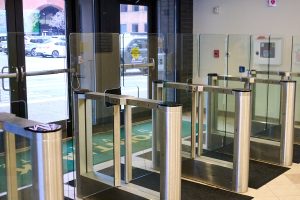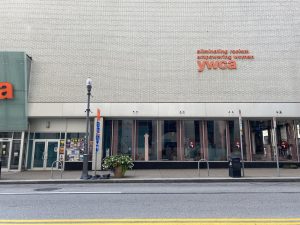Point Park announces new indoor mask policy
Masks to be optional indoors expect within instructional spaces and elevators
March 30, 2022
Point Park has announced an updated indoor mask policy in response to recent Center for Disease Control (CDC) guidelines, only requiring masks to be worn “in indoor instructional spaces and on the elevators.”
In an email sent on Tuesday, March 22, President Don Green announced revisions to the indoor mask policy for buildings on campus, which took effect on Monday, March 28. Along with the announcement, the university attached a statement about the school’s reasoning for the reduced restrictions.
“You may be aware that the Centers for Disease Control has updated their guidelines on the wearing of masks indoors,” Green said in the email. “The CDC relies on hospital capacities, new cases and hospitalizations to determine its COVID-19 community levels. When a county is at a low level, residents do not need to wear a mask in public indoor spaces. Allegheny County is rated at a low level by those CDC standards. The University’s COVID-19 Task Force recently echoed CDC recommendations for our campus.”
Both the CDC’s guidelines for risk levels (designated low, medium, and high), as well as the levels assigned to individual counties can be found on the organization’s website (CDC.gov).
Additionally, the statement made reference to polls conducted over the previous weeks in which students, faculty and staff were given an opportunity to provide feedback on the potential shift from the mandatory mask policy that was previously in place, to a mask-optional policy.
“We polled students, faculty, and staff to understand how our campus views an elimination of our indoor mask mandate,” Green said. “The results were clear. Large majorities of students, faculty and staff all relayed a preference for Point Park that we follow CDC recommendations and guidelines and allow optional masking.”
Green wrote in the email that most of the Point Park community — including students, faculty and staff — voted in favor of a mask-optional policy. The exact percentages, according to Associate Vice President of Institutional Research and Planning Chris Choncek, were 75% of students, 64% of faculty and 80% of staff in support of mask-optional.
However, despite Green’s assertion that the results reflected the opinions of “large majorities of students, faculty and staff,” it should also be noted that the number of responses to the survey actually represented a minority of the overall population. As reported in last week’s Globe issue, only an estimated 16% of students and 41% of faculty and staff participated in the survey, according to the number of responses reported by Choncek.
Still, the feelings of those who did not partake in the poll cannot be assumed one way or the other — and those who did participate did communicate a strong preference for a mask-optional policy.
Although the survey results indicated a desire to go mask-optional,the new rules still mandates masks to be worn in instructional spaces (such as classrooms) and elevators.
“In other areas of my life, I am around individuals both with and without masks,” Radio production and broadcast announcing professor Tracy Belak said. “It took some time, and a mental transition, to get used to being in areas with, and in close proximity to, others without a mask, but I have come to a point where I am comfortable with either situation.”
Belak added that many environments outside of the university no longer share Point Park’s mandatory mask rules, as federal mandates have already been lifted. Belak also said the fact that the survey results indicate a preference for lighter masking rules “show that there are many individuals who are ready to move forward without masks.”
Belak expressed comfort both with and without masks and a willingness to be flexible according to the university’s policies. This perspective is shared by other instructors at the university, including mathematics professor Matt Pascal.
“Even though I suspected more of my faculty peers to be in favor of a mask-optional campus policy, I trust that taking this step will still mitigate any potential spread,” said Pascal.
For Pascal, a transition to a fully optional indoor mask policy in the near future would be ideal, as he is comfortable with his own health and safety even without masking.
“I feel safe because I’m vaccinated and boosted, and I know that nearly everybody around me is too,” Pascal said. “Most people are no longer wearing masks off campus, inside buildings, and we’re not seeing an increase in spread among the campus community. So, I’m feeling confident that this is appropriate and safe.”
Despite this desire, however, Pascal realizes that not everyone shares his circumstances. As a result, he said he supports the more gradual transition to mask-optional reflected in the new policy in consideration of those who might be at a greater risk under an entirely optional policy.
“To be fair to my immunocompromised campus colleagues, and those with young children ineligible for vaccination, I think this is the right way to do things for now,” he said. “If we see that with this policy the spread continues to be mitigated, then I hope that the end of masks it’s too far off.”
Similar concerns regarding those under more vulnerable circumstances were also shared by communications department and creative writing professor Jennier Schaupp. Prior to the new policy being announced, Schaupp discussed her feelings on the mask-optional survey and the policy itself with The Globe for last week’s issue.
“I’m pretty sure based on the results that I’m in the minority, but I actually am comfortable with [the mandatory indoor mask policy], because everyone has different circumstances,” Schaupp said. “Some people are caregivers, some people are immunocompromised and you know, wearing it…I mean, it doesn’t hurt to protect people that way, you know?”
Schaupp, who voted in favor of keeping the previous policy in the faculty poll, had expressed concerns over the university attempting to apply a “one-size-fits-all” approach to creating a new policy.
“In my mind, I feel like if I sat all day in a cubicle or an office, I would feel differently than [if I was] interacting with people. I’m sure the nurse might feel differently than the maintenance staff, for example, just because of the nature of the interactions that are happening, so I just wonder if there always has to be a one-size-fits-all-answer,” she said. “Particularly with professors, you’re working a lot more closely with a lot more individuals, whereas in some other staff positions you’re maybe not as much… I don’t know if you ever tried a one-size-fits-all outfit, but we are not all made the same.”
After the new policy was announced, Schaupp shared her feelings on it in a follow-up interview.
“I was really surprised and really glad at the same time… the percentage of faculty was lower than the student percentage, as well as the staff percentage,” she said. “I assumed a one-size-fits-all model would happen, and [instead] a more nuanced approach happened that I feel took into consideration the slightly lower percentage from the faculty.”
Like Schaupp, mathematics professor and tutor Paul Spiker also shared his thoughts on the mask poll and policy in last week’s issue, prior to the announcement of the policy changes last week and had initially expressed concern for those who might be more vulnerable to the effects of the virus.
“Making the masks optional does little to help those who are concerned with getting COVID,” Spiker had said. “My mask protects others and only protects me a bit. There are people who have compromised immune systems. Even if they’ve been immunized and boosted, they may be vulnerable.”
Spiker, at the time, was also in support of maintaining the existing mandatory mask policy and felt that moving to a mask-optional policy now could be premature.
“The results concern me a little,” Spiker said. “It seems that most of the people surveyed are leaning towards giving everyone the option of going maskless. And though I agree that we eventually must reach that point, perhaps we should wait until the end of the semester. Once summer arrives, the weather will be nicer and most of us will spend more time outside. Also, there will be fewer students. Certainly, with numbers dropping, we would feel compelled to find normalcy. I look forward to going maskless. But I would hate for us to move too quickly. In about six weeks everyone will be going home again. I’d like to see what happens over the summer.”
In a follow-up interview after the new policy update, Spiker said that he was satisfied with the decision made by the university.
“I believe that the new policy is a nice compromise,” he said. “Nothing changes in the classroom. This seems fair. That’s a space where everyone must be present. Most students, it seems, would like to be mask free entirely… Nobody will be entirely happy. But to force those who still are uncomfortable being in a room filled with unmasked people to sit in such a space seems unnecessary. Wearing a mask in the classroom is a minor inconvenience at worst.”
Spiker said that the inconvenience of having to wear a mask is outweighed by the potential harm that could come by going without them. This sentiment is also shared by some of the student population, including SGA President Dennis McDermott.
“[Over] 70% of students agree that the last policy should be lifted,” McDermott said. “We did a survey ourselves; Vice President Summers conducted a survey of the university. In our survey at least, we looked at the 20% of students that still wanted [the mandate] to remain in place, and in the vast majority of those students we were seeing reasons like immunocompromised concerns.”
McDermott also said that he believed that students would likely not take issue with the policy remaining in place if more attention had been drawn to those concerns.
“I don’t think it would have been a big deal to have it remain for the remaining six weeks for the safety of those immunocompromised students, and I don’t think many students would have had an issue if that was stated as the reason [for keeping the mandate],” he said.
Last week, flyers were distributed across campus promoting a protest in Village Park on Tuesday, March 29 for the mask-optional policy to be extended to classroom and elevator operations.
Additionally, an Instagram account,‘@maskoptionalppu,’ was created and has since made multiple posts about the protest.
“We believe that the university has not met the students [sic] and staffs [sic] longing for having the choice to wear a mask, hence, [sic] why we have decided to hold a peaceful protest in hopes that the university will give students the option to mask or unmask within the classroom,” the account’s first post said. “This is not an anti-mask protest, we feel that students should have the choice within the classroom if [sic] they want to wear a mask or not.”


















